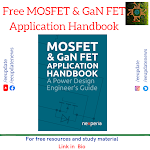Power Electronics Devices, Circuits, and Applications Fourth Edition Muhammad H. Rashid,
Title: Power Electronics: Devices, Circuits, and Applications
Author: Muhammad H. Rashid
Edition: Fourth
Publisher: Pearson Education
Audience: Undergraduate and graduate engineering students, educators, GATE/PSU aspirants
🔍 Introduction
Power electronics is the backbone of modern energy systems—from motor drives and renewable energy systems to electric vehicles and consumer electronics. In this space, "Power Electronics" by Muhammad H. Rashid stands tall as a foundational textbook for students and professionals alike.
Now in its fourth edition, the book continues to evolve, keeping pace with modern power semiconductor devices and control techniques, while maintaining its reputation for clarity, pedagogy, and practical application.
🧠 What Makes This Book Stand Out?
-
🧾 Structured Curriculum: The book follows a logically progressive layout that aligns with most university syllabi worldwide.
-
📉 Balanced Theory and Practice: It blends device physics, circuit-level analysis, and application-focused insights.
-
🧪 Rich Pedagogy: Offers extensive solved examples, end-of-chapter problems, and real-world case studies.
-
⚡ Updated Content: The fourth edition includes modern devices like IGBTs and MOSFETs, and enhanced coverage of applications like renewable energy systems and power supplies.
🧩 Chapter-Wise Breakdown (Simplified Overview)
| Section | Topics Covered |
|---|---|
| 1. Introduction | Basics of power electronics, applications, power conversion stages |
| 2. Power Semiconductor Devices | Diodes, BJTs, SCRs, MOSFETs, IGBTs, GTOs – operating principles and characteristics |
| 3. Diode Rectifiers | Single and three-phase rectifiers, performance analysis |
| 4. Phase-Controlled Converters | SCR-based controlled rectifiers, triggering, and control |
| 5. DC-DC Converters (Choppers) | Buck, boost, buck-boost, Cuk converters, continuous vs discontinuous modes |
| 6. Inverters | Single-phase and three-phase inverters, PWM techniques |
| 7. AC Voltage Controllers & Cycloconverters | On-off control, phase control, single/three-phase circuits |
| 8. Motor Drives | Speed control of DC/AC motors using converters and inverters |
| 9. Applications | SMPS, UPS, battery chargers, renewable energy systems, and more |
📌 What's New in the Fourth Edition?
-
Enhanced focus on IGBT and MOSFET switching behavior and characteristics
-
Expanded sections on PWM techniques and inverter control
-
Inclusion of digital control techniques and simulation tools
-
Updated examples to reflect modern applications like solar inverters and EVs
-
Improved visuals: waveforms, device diagrams, and simulation results
✅ Strengths of the Book
-
Student-Friendly Language: Rashid explains even complex concepts with clarity.
-
Strong Visual Aids: Lots of circuit diagrams and waveforms help with visualization.
-
Problem Sets: Each chapter has multiple-choice questions, conceptual reviews, and numericals.
-
Simulink/PSPICE Integration: Practical exposure to simulation environments.
-
Relevance to Modern Trends: Applications in EVs, solar, and smart energy systems.
⚠️ Possible Limitations
-
Lacks very deep mathematical rigor found in more advanced books like Erickson & Maksimovic
-
PWM and digital control techniques are introductory—not suitable for advanced control study
-
Might oversimplify device physics for students who need semiconductor-level insights
🆚 Comparison with Other Books
| Feature | Rashid | Bimbhra | Mohan | Erickson |
|---|---|---|---|---|
| Language | Student-friendly | Simple but traditional | Concept-focused | Very mathematical |
| Device Physics | Moderate | Basic | Moderate | Light |
| Control Techniques | Introductory | Limited | Strong | Advanced |
| Applications | Wide | Some | Motor drives focused | DC-DC focused |
| Use Case | UG/PG Students | Beginners | PG/Designers | Advanced researchers |
🎯 Who Should Use This Book?
-
📘 Students (UG/PG) – Perfect for coursework, assignments, and GATE/PSU preparation
-
🎓 Educators – Great reference for structured teaching
-
⚙️ Engineers and Hobbyists – Solid introduction to circuit design and simulation
-
❌ Not ideal for: Advanced researchers looking for deep mathematical modeling or control systems focus
🧰 Recommended Use Approach
-
Read chapter summaries before deep-diving into content
-
Practice numericals at the end of each chapter
-
Try simulation exercises using Multisim, PSIM, or MATLAB
-
Follow up with advanced texts like Mohan or Erickson for specialized topics
📚 Final Thoughts
Muhammad H. Rashid's Power Electronics (4th Edition) remains a cornerstone textbook in the field. Its clarity, coverage, and real-world orientation make it an indispensable resource for engineering students and young professionals aiming to master the art of power conversion.
If you're starting your journey in power electronics or brushing up your concepts for a competitive exam, this is a book you’ll keep returning to.
























No comments